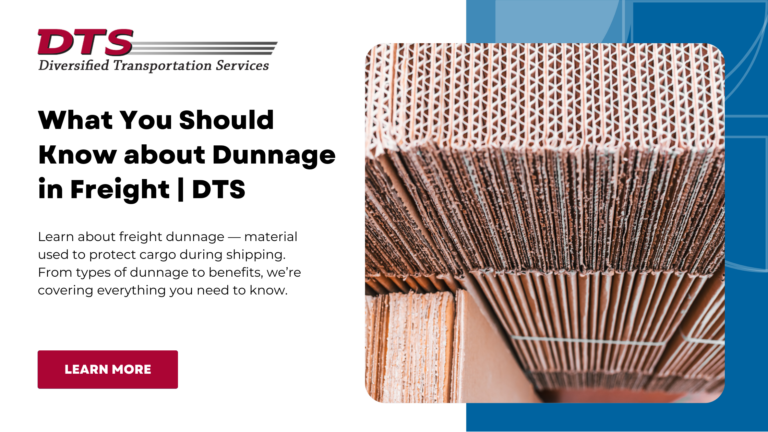
Freight logistics is much more than getting something from A to B. Carriers have an obligation to protect the goods they are transporting to ensure they reach their destination in good condition. Dunnage is an extremely useful material to keep your freight in good shape. It offers a low-cost and lightweight way of protecting goods during shipping.
But what exactly is dunnage, and how do carriers use it? Here’s what you need to know about freight dunnage.
Dunnage in freight shipping refers to materials used to protect, support, and secure cargo during transportation, preventing movement, damage, or contamination. It acts as a buffer between goods and the container or transportation platform. Common dunnage materials include wood, plastic, foam, air pillows, and fabric, which help stabilize loads and minimize the risk of shifting or impact.
Dunnage is particularly important when the shipping method leaves cargo exposed to external elements, like open deck or flatbed shipping. Dunnage helps protect the goods from the elements and weather while ensuring everything remains stable on the flatbed.
Most people just see dunnage as a useful tool to help protect goods in transit. However, it also plays a critical role in keeping shipping operations efficient, safe, and compliant.
Shipping companies are often legally required to secure cargo in specific ways to ensure safe transportation. For example, international shipping standards often require that certain goods like food or chemicals be packed with moisture-resistant dunnage to prevent contamination, particularly when crossing borders.
Staying compliant with shipping regulations is essential for protecting cargo from damage and ensuring safe handling practices. These regulations dictate how cargo should be secured and transported, reducing the risk of accidents that could lead to cargo damage and personnel injuries.
Of course, dunnage’s ability to prevent damage is also vital. Dunnage acts as a physical barrier to prevent items from colliding with one another or shifting within the container, minimizing the risk of damage. It’s also incredibly useful for filling empty spaces between cargo, which helps increase load stability. Plus, it reduces the overall risk of breakage, scratches, or moisture damage.
Dunnage comes in various forms, and each type can serve a different purpose. Here are the main types of freight dunnage you might come across:
Many carriers will use pieces of wood as dunnage. These sturdy wood scraps are commonly used to brace or block cargo. Wood dunnage is often used for strong, heavy goods freight and is common in flatbed shipping.
Solid plastic dunnage is strong, lightweight, and reusable — though it’s more expensive than other types of dunnage. It’s often used to protect shipments from scratches and is good for high-value or delicate shipments.
Foam is a versatile dunnage material. It helps absorb shocks and protects fragile goods. It’s also easy to cut into different shapes and sizes, which makes it a great choice for custom dunnage needs.
Corrugated paper is a lightweight material made of two layers of paper with a fluted layer in the middle. Corrugated paper can support a range of weights and helps protect freight against moisture. Plus, it’s biodegradable, making it a more sustainable option than other types of freight dunnage.
Plastic bubble wrap is one of the most popular choices when shipping fragile cargo. It provides great cushioning for delicate shipments and can be used multiple times if the bubbles don’t pop during transit.
Steel is a great dunnage option for heavy-duty protection. It’s typically used when shipping industrial goods and can ensure heavy items don’t shift too much during shipping or damage lighter cargo.
Here are the main benefits of using freight dunnage:
Trick drivers will typically carry 5 to 10 pieces of dunnage. This will usually include dunnage for general purposes, like rubber mats and wooden blocks that will stop cargo from moving around as the truck goes over bumps in the road. Typical wood dunnage sizes tend to range from 2x4, but they can be of any length.
The amount and types of dunnage carried by drivers will vary, depending on the nature of the cargo. For example, they may carry more pieces of dunnage if they’re carrying irregularly shaped, fragile, or delicate items. In that situation, they may also use additional types of dunnage such as air pillows and foam to help protect the fragile goods.
Drivers using flatbed trucks will also need to carry more dunnage to secure and brace freight, especially for oversized loads.
Getting dunnage right is essential for keeping shipments damage-free. Partnering with the right logistics partner can help ensure your freight always has the dunnage it needs. DTS's years of experience in the freight industry means we can coordinate all things shipping like packing and dunnage.
Whether you're a company looking to improve one facet of your supply chain, your entire supply chain, or simply looking for a transportation and logistics consultation, we can help.